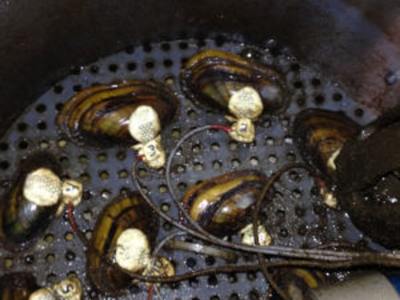Sensors aren’t just limited to the electrical, mechanical, or chemical realm. Up until 1986, canaries were used as Carbon Monoxide detectors, and food tasters are still used by some heads of state. These so-called sentinel species have been known and used for decades if not centuries. But recent projects using clams to detect water pollution are providing real-time electronic feedback. They are using the species Actinonaias ligamentina, which, as you no doubt recall, was declared “Mussel of the Month” by the University of Wisconsin’s MUSSEL Project back in January 2010. They are more commonly known as mucket clams or mucket mussels, and are particularly sensitive to water pollution — they will clam-up, so to speak, in the presence of contaminated water.

Several municipalities along the Mississippi River installed clam-based sensors back in 2015, and another system was installed in the Anacostia River Estuary in 2011. Polish director Julia Pekla produced a documentary about the clam-based sensors installed at the Dębiec Water Treatment Plant on the Wisła River near Warsaw which has been in operation since 1994. Her documentary is titled “Gruba Kaśka (Fat Kathy)” and won the In Vivo Award at the 2020 Imagine Science Film’s 13th annual film festival (see trailer below).
As shown in the lead photo, a simple electrical contact is mounted on each clam, which closes a circuit with the base contact when the shell is clamped shut. The systems along the Mississippi River use multiple clams, 11 in Minneapolis Minnesota and 16 in Moline Illinois. The system in Poland uses eight clams — when four or more clams are in agreement the system automatically shuts down and alerts the operators. These clams only work for three months, after which they are put into retirement with a mark so they won’t be required to serve again.
We’ve written about a clam-shaped underwater sensor before, and also reported on the potential of using clams as batteries. This biological sensing technique came to our attention via [Embedded FM podcast #357].
















This would have made a great example for the yesterday hack chat.
Clam conditioned water quality sensor :D
“Clamtastic water quality” as a new slogan?
So if I get a cage of canaries, a moat full of clams and surround it all with a field of spinach, I’m protected against everything?
There is always the option of an orbital tunsten rod bombarement, against which there is little to no protection.
Hmmmm, you could be right, how do you breed and train those giant asteroid dwelling space slugs seen in Empire Strikes Back ?
Oh you mean politicians? They don’t take well to training.
I think you got them confused with hemorrhoid dwelling debased slugs.
Would it be simpler to just attach a tilt switch to top of the clams ? Some tilt switches have a little steel ball in them – probably better than the ones that have a bit of mercury in them – although, if a mercury switch broke, that would pollute the water and the other clams would send their notification out and the techs would come to fix the problem.
I think the gap and spring would act as a buffer of sorts against environmental movements, maybe clam moves a bit or something, causing false signal?
Mount each clam on top of a magnet, and glue a Hall sensor to the top shell, and watch for changes in the signal?
Linear hall sensors make everything better. Electrical contacts just aren’t all that reliable, and they need everything to be mechanically aligned just right.
Hall sensors just work, and it’s awesome.
C’mon guys, you’re missing the obvious best solution here. We want clams with frickkin’ lasers on…
I’m guessing this system is easier to calibrate.
Giving clams retirement is just the best thing ever! I love it!
How about OCR, optical clam recognition. An open and shut case.
exactly was I was thinking. I am sure I could develop an underwater camera system that detects if the clam opens. And maybe, but I am less sure about it, maybe using a normal IP67 camera above the water.
*what I was thinking*
Anybody knows if a laser distance meter could work for submerged object?
Wilbur Smith’s book “Hungry as the sea” from 1978 has a character testing the sensitivity of clams to various pollutants, wired up to an ECG. From that, I assume the concept was reasonably well known, if not before, then at least after the book was published.
Amazing that it has taken this long to actually start using the technique in the field!
1978 scientific reaserch, 1995 first real life deployment (in Poland that just 5 years earlier stopped being commie land and still was Africa level of poverty) and 2015 USA follows :D
“Dębiec Water Treatment Plant on the Wisła River near Warsaw” there is a mistake. Dębiec Water Treatment Plant is on Warta River in Poznań.